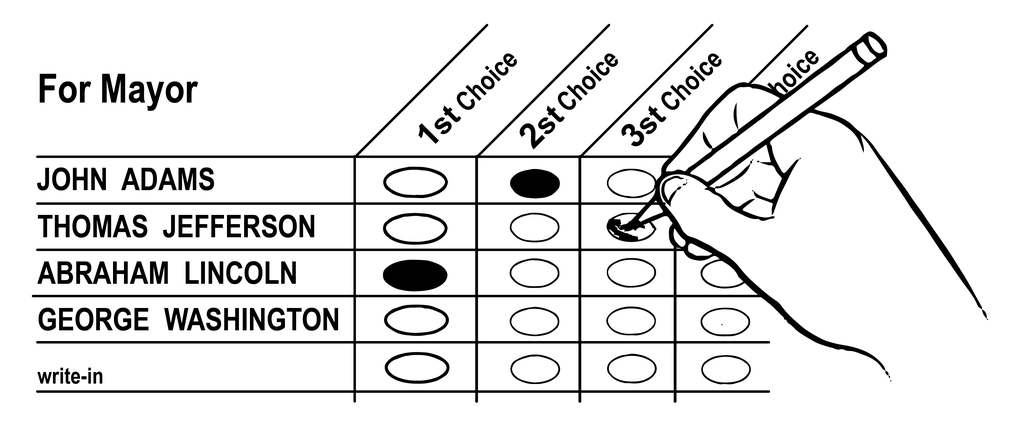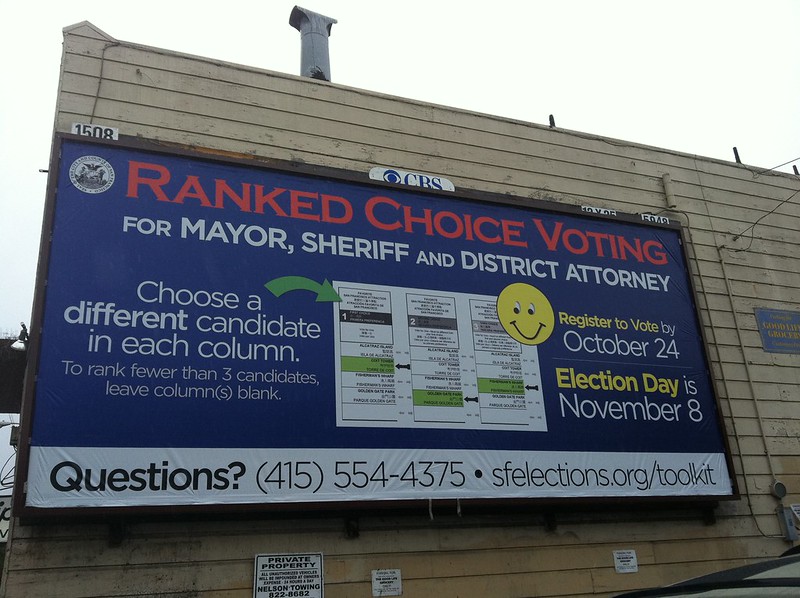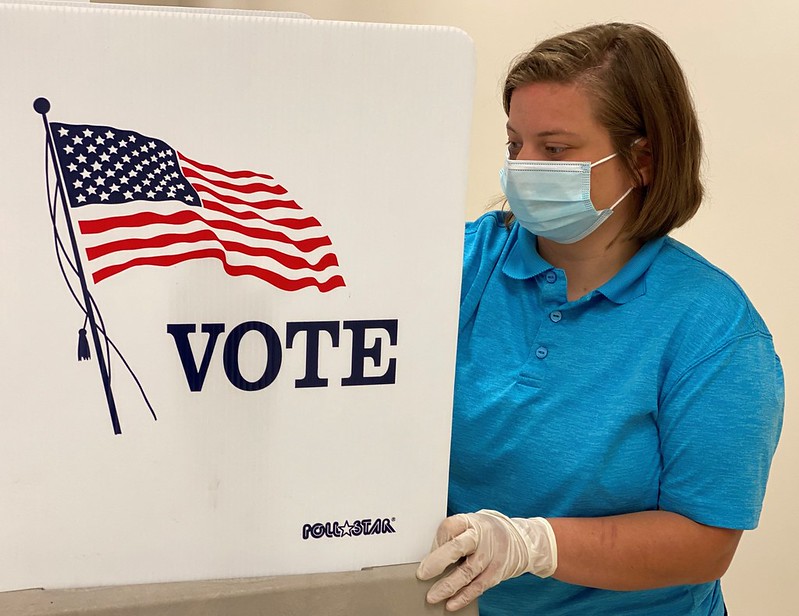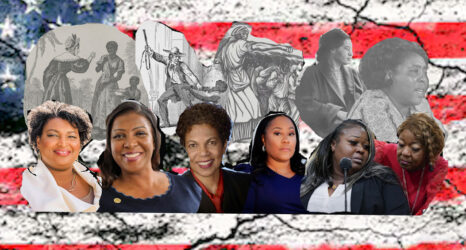Ranked-choice voting could be the future of elections in America.

This November, voters in two states (Massachusetts and Alaska) and five cities will decide the fate of ballot measures to enact ranked-choice voting—a process proven to make democracy more fair and functional and to ensure elections are fair for all voters.
What is Ranked-Choice Voting?
Ranked-choice voting (RCV) allows voters the option to rank candidates in order of preference: one, two, three and so forth. If your vote cannot help your top choice win, your vote counts for your next choice.
In races where voters select one winner, if a candidate receives more than half of the first choices, that candidate wins, just like in any other election.
But if there is no majority winner after counting first choices, the race is decided by an “instant runoff”—where the candidate with the fewest votes is eliminated, and voters who picked that candidate as ‘number 1’ will have their votes count for their next choice. This process continues until there’s a majority winner or a candidate won with more than half of the vote.
Ranked Choice Voting 2020 Ballot Measures
The following two states and five cities have ballot measures to enact ranked-choice voting (RCV) on the ballot in November.
Alongside an approved ballot measure earlier this year in Portland, Maine, to extend use of RCV for all city elections, these seven ballot measures represent the most jurisdictions voting on RCV in one year in American history.
Alaska
Alaskans for Better Elections collected enough signatures to put Ballot Measure 2 to a vote this November. If passed, this ballot measure would implement several statutory changes, including:
- “Top four” blanket primaries for state and congressional offices, where all candidates would appear on the same primary ballot and the top four vote-getters would advance to the general election, regardless of party affiliation;
- Ranked-choice voting in the choice among four candidates on the November ballot, with write-in candidates permitted; and
- Ranked-choice voting in the presidential election among all candidates who have qualified for the ballot and any write-in candidates.
If you live in Alaska, vote YES on Ballot Measure 2.
Read a quick take post from FairVote’s blog.
Albany, California
The city council of Albany, Calif., voted unanimously on June 15 in favor of charter amendment for voters to approve the adoption of the proportional form of ranked-choice voting for elections to the city council and school board, which are elected citywide in staggered elections.
The RCV Ballot Measure BB will be decided in November. Albany would be the fifth city in California with ranked-choice voting and the fourth city in the country using its proportional, “single transferable vote” form. Voter Choice Albany heads the campaign, and backers include the local East Bay Times in this thoughtful editorial.
If you live in Albany, vote YES on Ballot Measure BB.
Read a quick take from FairVote’s blog.
Bloomington, Minnesota
The city council of Bloomington, Minn., voted 6-1 in favor of a charter amendment to go on the November ballot adopting RCV in elections for mayor and council.
If voters approve City Question 3, Bloomington would join three Minnesota cities that already use RCV. For more on the campaign, visit Ranked Choice Voting Bloomington.
If you live in Bloomington, vote YES on City Question 3.
Read a quick take post from FairVote’s blog.
Boulder, Colorado
In August, the Boulder, Colo., city council approved 7-2 to place a charter amendment on the ballot to allow voters to elect their mayor directly with ranked-choice voting; currently, the city council selects the mayor.
On September 1, the council held a final vote that put Ballot Measure 2E before voters. The campaign in support of the measure is led by Our Mayor, Our Choice. Endorsers include the Boulder Daily Camera in this editorial.
If you live in Boulder, vote YES on Ballot Measure 2E.
Read a quick take post from FairVote’s blog.
Eureka, California
The city council of Eureka, Calif., voted unanimously (5-0) to place a charter amendment on the November ballot to adopt RCV voting for electing the mayor and city council.
Measure C would replace the current plurality voting system and make Eureka the fifth city in California with RCV. Yes on C! Ranked Choice Voting for Eureka has a website and Facebook page.
If you live in Eureka, vote YES on Measure C.
Read a quick take post from FairVote’s blog.
Massachusetts
After a multi-year educational campaign led by Voter Choice Massachusetts, an initiative will appear on the ballot as Question 2 that, if passed, would enact a statute to implement RCV for Massachusetts’s U.S. Senate and U.S House general and primary elections, state primary and general elections, and county offices, beginning in 2022.
The initiative is supported by Yes on 2 for Ranked Choice Voting. Supporters include the Boston Globe in this editorial and at least five additional Massachusetts newspapers.
If you live in Massachusetts, vote YES on Question 2.
Read a quick take post from FairVote’s blog.
Minnetonka, Minnesota
The city council of Minnetonka, Minn., voted unanimously to place a charter amendment on the November ballot to fold the city’s nonpartisan primary elections into a single general election held with RCV for mayor and city council.
If the city ballot question is passed, Minnetonka would join three Minnesota cities that already use RCV. The campaign to pass City Question is led by Ranked Choice Voting Minnetonka.
If you live in Minnetonka, vote YES on City Question.
Read a quick take post from FairVote’s blog.
Benefits of Ranked-Choice Voting

Ranked-choice voting is a non-partisan reform which gives voters more voice and more choice in our elections. RCV benefits voters more than any one political party because it promotes majority support and creates incentives for candidates to reach out to a larger audience of voters, rather than just one political base.
1. Promotes Majority Support
Too often, candidates win elections despite being opposed by most voters. In elections with more than two candidates, candidates can and do win even when less than half of voters support them.
With RCV for single-winner offices, if no candidate has a majority in first choices, the candidates in last place will be eliminated one-by-one. If a voter’s first choice is eliminated, their vote instantly goes to their second choice. That way, we can find out which of the top candidates has real majority support.
2. Discourages Negative Campaigning
In non-RCV elections, candidates benefit from mudslinging and attacking their opponent instead of sharing their positive vision with voters—which can lead to toxic, polarizing campaigns.
With RCV, candidates also compete for second choice votes from their opponents’ supporters—lessening the incentive to run a negative campaign. In fact, voters in RCV cities report more positive campaigning and greater satisfaction with their elections.
3. Provides More Choice for Voters
Often, to avoid “vote splitting”—in which candidates win with very little support—efforts are taken to limit the number of candidates who compete.
This can manifest in several ways. For example, a low turnout primary election eliminates most of the candidates, restrictive ballot access laws keep out challengers or, lastly, candidates (especially those from underrepresented groups) are sometimes pressured to stay out of the race for fear of splitting the vote with another similar candidate.
RCV allows more than two candidates to compete without fear of “splitting the vote” among like-minded individuals.

4. Saves Money When Replacing Preliminaries or Runoffs
Many local offices are elected in two rounds of elections: either a primary election followed by a general election, or a general election followed by a runoff election if no candidate won a majority.
In either case, the election that takes place on a day other than the general Election Day often suffers from weak and unrepresentative turnout. But with RCV, a jurisdiction can enjoy the benefits of two rounds of voting in a single, more representative, higher-turnout election—while also saving money, since there is no need for a second election.
5. Promotes Reflective Representation
Compared to winner-take-all elections, RCV in multi-winner contests allows diverse groups of voters to elect candidates of choice. This promotes diversity of political viewpoint as well as diversity of candidate background and demographics.
Even in single-winner races, RCV can promote the representation of historically underrepresented groups.
6. Minimizes Strategic Voting
In elections without RCV, voters may feel that they need to vote for the “lesser of two evils,” because their favorite candidate is less likely to win or is perceived as less “electable.”
With RCV, voters know that if their first choice doesn’t win, their vote automatically counts for their next choice instead. This frees voters from worrying about how others will vote and which candidates are more or less likely to win.
7. Increased Participation from Military and Overseas Voters
Deployed military and other overseas voters encounter particular challenges during runoff elections and presidential nominating contests. However, RCV ballots allow a military or overseas voter to know their vote will matter—if a runoff occurs, or if candidates drop out of a presidential contest, the ranked ballot is counted for whichever candidate in the runoff the overseas voter ranked highest.
Jurisdictions Already Using RCV
- Cambridge, Mass.: In use since the 1940s in multi-winner form. Used for the nine-seat city council and the six-seat school board, both elected citywide.
- Las Cruces, N.M.: Adopted by the city council in 2018 and used since 2019 for all municipal elections.
- Maine: Adopted in 2016 and first used in 2018 for all state and federal primary elections, and all general elections for Congress. Extended to apply to the general election for president beginning in 2020 and presidential primary elections beginning in 2024.
- Payson, Utah: A local options bill was passed in 2018, and the city opted-in for city council seats in November 2019 (at-large, winner take-all).
- San Francisco: Adopted in 2002 and used since 2004 to elect the mayor, city attorney, Board of Supervisors and five additional citywide offices.
- St. Paul, Minn.: Adopted in 2009 and used since 2011 to elect the mayor and city council.
- Takoma Park, Maryland: Adopted in 2006 and used since 2007 in all elections for mayor and city council.
Momentum for Ranked-Choice Voting Continues to Build
Burlington, Vermont, will vote on March 3, 2021, on enacting RCV for most city elections.
North Dakota Voter’s First, a grassroots coalition, submitted 36,000 signatures for a ballot initiative that would have enacted several changes, including a “Top Four Primary” with RCV. It was approved by the secretary of state, but the North Dakota Supreme Court on August 25 removed it from the ballot because it ruled that petitions should have included the full text of the ballot measure.
Open Primaries Arkansas, a grassroots coalition that gathered sufficient signatures to earn a place on the November ballot, also was deeply disappointed to have its “Top Four Primary” with RCV struck from the ballot by the Arkansas Supreme Court on procedural grounds involving signature collection.
Several additional cities seriously considered placing ranked-choice voting on the ballot and are likely to take action in 2021-22. Other cities are expected to establish RCV for their 2021 elections by an act of the city council.
This post originally appeared on FairVote. It has been republished with permission.
You may also like:





